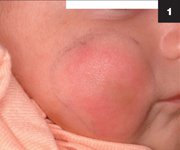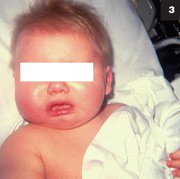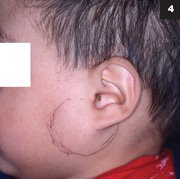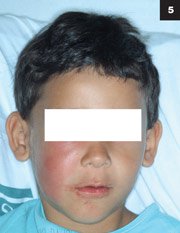9-week-old female with cheek swelling
Click Here to Manage Email Alerts
A 9-week-old female infant was admitted for evaluation and treatment of right buccal cellulitis. The history of the chief complaint revealed that the baby was bitten on the right cheek two days earlier at her daycare center by a 2-year-old. Erythema and swelling were noted soon after the event and appeared to be persistent over the next two days; therefore, she was taken to the local emergency room. The mother reports that the baby is slightly more fussy than usual, but her appetite and activity have not changed. She had no fever during this time, but has noted some mild nasal congestion.
Her past medical history is complicated by mother being colonized with group B strep at delivery. The mother received antimicrobial prophylaxis before delivery (two doses of penicillin) and the baby also received ampicillin and gentamicin for 48 hours. The baby also received the hepatitis B immunization before discharge from couplet care, but has not yet received her 2-month immunizations. The rest of her PMHx is unremarkable.

Pediatric Infectious Disease, Scott and White's Children's Health Center and Associate Professor of Pediatrics,
Texas A&M University, College of Medicine, Temple, Texas.
e-mail: jhbrien@aol.com
At the referring hospital emergency room, the baby was diagnosed with buccal cellulitis and given a dose of clindamycin and Unasyn (ampicillin-sulbactam) before transfer. No lab tests were performed before arrival.
Examination on admission revealed an alert and active 9-week-old baby in no distress who was feeding well. Her vital signs were normal, including her temperature. Her examination was normal with the exception of the area of erythema and swelling over her right cheek, with some brownish discoloration in the center of the area, as seen in figures 1 and 2. There was no break in the skin, and the buccal mucosa appeared normal. Her admitting lab tests included a complete blood count, which showed a white blood cell count of 17,400 with 66% lymphocytes and 28% granulocytes, and 652,000 platelets, with a blood culture that is pending.
 |
 |
|
The patient had an area of erythema and swelling over her right cheek, with some brownish discoloration in the center of the area. All photos courtesy of James H. Brien.
|
|
What’s Your Diagnosis?
- Dental abscess
- Buccal cellulitis
- Facial injury
- Parotitis
Case Discussion
We may never know for sure, but in my opinion, after considering all the factors in the history and physical findings, I think this child had a simple injury (C) to her cheek, which unfortunately looks much the same as cellulitis and is in the same location that classic Haemophilus influenzae type b buccal cellulitis would occur and which once occurred on a frequent basis before the widespread use of conjugated Hib vaccine. Hib buccal cellulitis results from bacteremia with the organism (remember, Haemophilus is from the Greek language meaning blood loving) and carries a significant risk for concomitant meningitis. Plus, those children are likely to be febrile and sick-appearing (figure 3) upon presentation. Therefore, if you have a baby with a febrile illness, especially if incompletely immunized, with cellulitis of the cheek, the patient should probably have a spinal tap as part of the evaluation, and treatment should include a third-generation cephalosporin. Like all invasive Hib disease, this is almost unheard of nowadays. This patient was initially treated with antimicrobials as for common cellulitis due to a bite with clindamycin and ampicillin-sulbactam (Unasyn). But again, if there really was cellulitis, there should have been a fever and probably a break in the skin to serve as a port of entry. The one element of concern in this case might be the CBC results. However, I probably would not have done the CBC or treated with antibiotics at all unless the condition progressed. Of course, the blood culture was negative.
 |
 |
|
Children with Haemophilus influenzae type b buccal cellulitis are often febrile and sick-appearing.
|
A patient with parotitis.
|
 |
 |
|
If an older child had a cheek cellulitis, it may look similar as a maxillary tooth abscess.
|
|
Parotitis may look very similar (figure 4). The difference would be in the shape of the swelling; the location would be preauricular, and parotitis usually has no overlying erythema. You may also be able to express some discharge from Stensen’s duct if it is acute suppurative parotitis.

Lastly, a dental abscess would be unheard of in a young infant. However, if an older child had a cheek cellulitis, it may look similar as a maxillary tooth abscess (figures 5 and 6). A mandibular tooth abscess would be located farther down on the face or neck (figure 7). Of course, a simple oral examination will usually reveal the problem.
Columnist comments
Every now and then I use this space to pay respects to a recently departed pediatrician of special historic note. Regrettably, such is the case this month. I recently learned of the death of Angelo M. DiGeorge, MD, last October 11 at 88 years of age. I never met Dr. DiGeorge, but I, like pediatricians all over the world, recognize his name as the one who described one of the most common genetic disorders that we see (about 1 in every 4,000 live births). As a pediatric endocrinologist at Temple University College of Medicine in Philadelphia, DiGeorge described the syndrome, a congenital absence of the thymus with its immunologic consequences in 1968, which was subsequently found to be caused by a deletion of a portion of the 22nd chromosome. Since then, DiGeorge Syndrome has found its place in the core curriculum of academic pediatrics. Iconic as he may be for this syndrome, the legacy of Dr. DiGeorge will be in the careers of the many hundreds of students and residents and dozens of endocrine fellows he trained over the last half of the 20th century. It is also noteworthy that similar to many great physicians, before completing his postgraduate training, DiGeorge served in the post World War II U. S. Army Medical Corps from 1947 to 1949 with duty at the 124th Station Hospital in Austria. Dr. DiGeorge represents the type of role model, with a passion for teaching and discovery, that we should be teaching young physicians to emulate. The pediatric world today, especially in Philadelphia, is a little less bright without Dr. DiGeorge. A very nice obituary and picture can be found at The International 22q11.2 Deletion Syndrome Foundation Inc.
